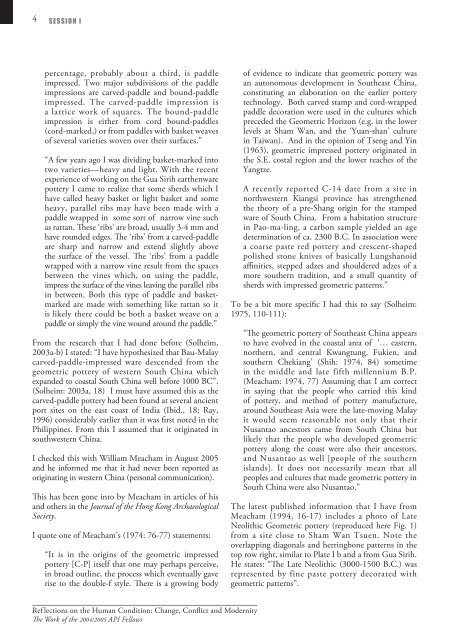Reflections on the Human Condition - Api-fellowships.org
Reflections on the Human Condition - Api-fellowships.org
Reflections on the Human Condition - Api-fellowships.org
You also want an ePaper? Increase the reach of your titles
YUMPU automatically turns print PDFs into web optimized ePapers that Google loves.
4<br />
SESSION I<br />
percentage, probably about a third, is paddle<br />
impressed. Two major subdivisi<strong>on</strong>s of <strong>the</strong> paddle<br />
impressi<strong>on</strong>s are carved-paddle and bound-paddle<br />
impressed. The carved-paddle impressi<strong>on</strong> is<br />
a lattice work of squares. The bound-paddle<br />
impressi<strong>on</strong> is ei<strong>the</strong>r from cord bound-paddles<br />
(cord-marked,) or from paddles with basket weaves<br />
of several varieties woven over <strong>the</strong>ir surfaces.”<br />
“A few years ago I was dividing basket-marked into<br />
two varieties—heavy and light. With <strong>the</strong> recent<br />
experience of working <strong>on</strong> <strong>the</strong> Gua Sirih ear<strong>the</strong>nware<br />
pottery I came to realize that some sherds which I<br />
have called heavy basket or light basket and some<br />
heavy, parallel ribs may have been made with a<br />
paddle wrapped in some sort of narrow vine such<br />
as rattan. These ‘ribs’ are broad, usually 3-4 mm and<br />
have rounded edges. The ‘ribs’ from a carved-paddle<br />
are sharp and narrow and extend slightly above<br />
<strong>the</strong> surface of <strong>the</strong> vessel. The ‘ribs’ from a paddle<br />
wrapped with a narrow vine result from <strong>the</strong> spaces<br />
between <strong>the</strong> vines which, <strong>on</strong> using <strong>the</strong> paddle,<br />
impress <strong>the</strong> surface of <strong>the</strong> vines leaving <strong>the</strong> parallel ribs<br />
in between. Both this type of paddle and basketmarked<br />
are made with something like rattan so it<br />
is likely <strong>the</strong>re could be both a basket weave <strong>on</strong> a<br />
paddle or simply <strong>the</strong> vine wound around <strong>the</strong> paddle.”<br />
From <strong>the</strong> research that I had d<strong>on</strong>e before (Solheim,<br />
2003a-b) I stated: “I have hypo<strong>the</strong>sized that Bau-Malay<br />
carved-paddle-impressed ware descended from <strong>the</strong><br />
geometric pottery of western South China which<br />
expanded to coastal South China well before 1000 BC”.<br />
(Solheim: 2003a, 18) I must have assumed this as <strong>the</strong><br />
carved-paddle pottery had been found at several ancient<br />
port sites <strong>on</strong> <strong>the</strong> east coast of India (Ibid., 18; Ray,<br />
1996) c<strong>on</strong>siderably earlier than it was first noted in <strong>the</strong><br />
Philippines. From this I assumed that it originated in<br />
southwestern China.<br />
I checked this with William Meacham in August 2005<br />
and he informed me that it had never been reported as<br />
originating in western China (pers<strong>on</strong>al communicati<strong>on</strong>).<br />
This has been g<strong>on</strong>e into by Meacham in articles of his<br />
and o<strong>the</strong>rs in <strong>the</strong> Journal of <strong>the</strong> H<strong>on</strong>g K<strong>on</strong>g Archaeological<br />
Society.<br />
I quote <strong>on</strong>e of Meacham’s (1974: 76-77) statements:<br />
“It is in <strong>the</strong> origins of <strong>the</strong> geometric impressed<br />
pottery [C-P] itself that <strong>on</strong>e may perhaps perceive,<br />
in broad outline, <strong>the</strong> process which eventually gave<br />
rise to <strong>the</strong> double-f style. There is a growing body<br />
Ref lecti<strong>on</strong>s <strong>on</strong> <strong>the</strong> <strong>Human</strong> C<strong>on</strong>diti<strong>on</strong>: Change, C<strong>on</strong>flict and Modernity<br />
The Work of <strong>the</strong> 2004/2005 API Fellows<br />
of evidence to indicate that geometric pottery was<br />
an aut<strong>on</strong>omous development in Sou<strong>the</strong>ast China,<br />
c<strong>on</strong>stituting an elaborati<strong>on</strong> <strong>on</strong> <strong>the</strong> earlier pottery<br />
technology. Both carved stamp and cord-wrapped<br />
paddle decorati<strong>on</strong> were used in <strong>the</strong> cultures which<br />
preceded <strong>the</strong> Geometric Horiz<strong>on</strong> (e.g. in <strong>the</strong> lower<br />
levels at Sham Wan, and <strong>the</strong> ‘Yuan-shan’ culture<br />
in Taiwan). And in <strong>the</strong> opini<strong>on</strong> of Tseng and Yin<br />
(1963), geometric impressed pottery originated in<br />
<strong>the</strong> S.E. costal regi<strong>on</strong> and <strong>the</strong> lower reaches of <strong>the</strong><br />
Yangtze.<br />
A recently reported C-14 date from a site in<br />
northwestern Kiangsi province has streng<strong>the</strong>ned<br />
<strong>the</strong> <strong>the</strong>ory of a pre-Shang origin for <strong>the</strong> stamped<br />
ware of South China. From a habitati<strong>on</strong> structure<br />
in Pao-ma-ling, a carb<strong>on</strong> sample yielded an age<br />
determinati<strong>on</strong> of ca. 2300 B.C. In associati<strong>on</strong> were<br />
a coarse paste red pottery and crescent-shaped<br />
polished st<strong>on</strong>e knives of basically Lungshanoid<br />
affinities, stepped adzes and shouldered adzes of a<br />
more sou<strong>the</strong>rn traditi<strong>on</strong>, and a small quantity of<br />
sherds with impressed geometric patterns.”<br />
To be a bit more specific I had this to say (Solheim:<br />
1975, 110-111):<br />
“The geometric pottery of Sou<strong>the</strong>ast China appears<br />
to have evolved in <strong>the</strong> coastal area of ‘… eastern,<br />
nor<strong>the</strong>rn, and central Kwangtung, Fukien, and<br />
sou<strong>the</strong>rn Chekiang’ (Shih: 1974, 84) sometime<br />
in <strong>the</strong> middle and late fifth millennium B.P.<br />
(Meacham: 1974, 77) Assuming that I am correct<br />
in saying that <strong>the</strong> people who carried this kind<br />
of pottery, and method of pottery manufacture,<br />
around Sou<strong>the</strong>ast Asia were <strong>the</strong> late-moving Malay<br />
it would seem reas<strong>on</strong>able not <strong>on</strong>ly that <strong>the</strong>ir<br />
Nusantao ancestors came from South China but<br />
likely that <strong>the</strong> people who developed geometric<br />
pottery al<strong>on</strong>g <strong>the</strong> coast were also <strong>the</strong>ir ancestors,<br />
and Nusantao as well [people of <strong>the</strong> sou<strong>the</strong>rn<br />
islands]. It does not necessarily mean that all<br />
peoples and cultures that made geometric pottery in<br />
South China were also Nusantao.”<br />
The latest published informati<strong>on</strong> that I have from<br />
Meacham (1994, 16-17) includes a photo of Late<br />
Neolithic Geometric pottery (reproduced here Fig. 1)<br />
from a site close to Sham Wan Tsuen. Note <strong>the</strong><br />
overlapping diag<strong>on</strong>als and herringb<strong>on</strong>e patterns in <strong>the</strong><br />
top row right, similar to Plate I b and a from Gua Sirih.<br />
He states: “The Late Neolithic (3000-1500 B.C.) was<br />
represented by fine paste pottery decorated with<br />
geometric patterns”.

















